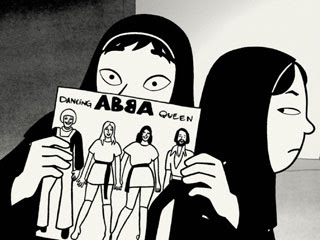This piece on Persepolis, by Amber Leab, first appeared at Bitch Flicks on July 1, 2009.
In Persepolis, we meet Marjane (Satrapi), a young girl living in Iran at the time of the Islamic revolution of 1979. The society changed drastically under Islamic law, as evidenced by Marjane’s teacher’s evolving lessons. After the revolution, in 1982, she tells the young girls, who are now required by law to cover their heads, “The veil stands for freedom. A decent woman shelters herself from men’s eyes. A woman who shows herself will burn in hell.” In typical fashion, the students escape her ideological droning through imported pop culture: the music of ABBA, The Bee Gees, Michael Jackson, and Iron Maiden.
While the film is a personal story, it does offer a concise history of modern Iran, including the U.S. involvement in the rise of Islamic law and in the Iran-Iraq war. This time in Iranian history is especially important right now, with the disputed re-election of President Mahmoud Ahmadinejad and the ensuing protests. One scene in particular depicts a group of people protesting when a young man is shot, bleeds to death, and is hoisted over his fellow protesters’ shoulders–eerily reminiscent of what happened with Neda Agha Soltan, whose public murder has rallied the Iranian protesters and people all over the world.

